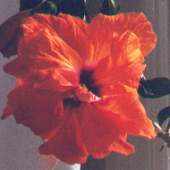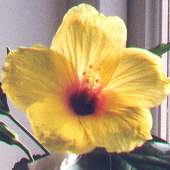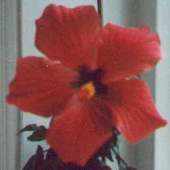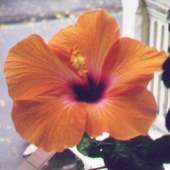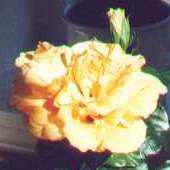
Tropical Hibiscus in SwedenHibiscus rosa-sinensis is considered an exotic tropical plant. So how has it become so widely grown here in Sweden? Because it is an excellent potted plant! Hibiscus rosa-sinensis has been a common plant in Sweden for more than fifty years. With summer daytime temperatures averaging 15-26 degrees C (60-80F), night-time slightly lower, this climate is never ideal for tropical hibiscus. In a garden they grow but rarely flower until taken in before frost. For outdoor growing Hibiscus syriacus is much preferred. |
|||||||
 |
Growing tropical hibiscus the Swedish way means affixing shelves beneath windows. Hibiscus need light so choose a south or west window. To keep plants from drying out too soon use double pots; an inner plastic and an outer ceramic planter. In warmer climes than Sweden the shelf should be affixed a little lower so that pots get protected by the wall. This arrangement works very well which show itself in blooms, even during winter months. Artificial pollination will often result in fertile seedpods. Potted hibiscus, when well cared for, can become very old, 40 years or more. | ||||||
Some hibiscus cultivars grown in Sweden
Common difficulties peculiar to house grown hibiscus:Pests: The ones to especially look out for with house grown hibiscus are spider mites, compliments of a dry indoor environment. These can be somewhat combated by proper showers once a week. Excessive size: Pruning will be needed. Ideal time is in fall, August - October, but spring pruning is practised by some with good results. For a well balanced plant try to establish three main branches. These are shortened to 1/3, all the rest completely cut back. For extremely vigorous plants a cautious root pruning, never more than 1/3 of the rootball, might be utilised in connection with spring replanting. Replanting: Commonly occur once a year in spring. Carefully lift the whole plant out of the pot. Remove as much of the old soil as possible. Choose a new pot one size larger than the old. For some plants the roots have to be cut back too (see above). Replant in well draining soil. Drought: Hibiscus rosa-sinensis is fairly drought tolerant. Water regularly but do not leave water standing in the planter. Fertilise every week even in winter (half strength) with low P (phosphorous) fertiliser, but NEVER when the soil is bone-dry. It can burn the roots badly. Yellow leaves: Often the result of underwatering. Can also occur when plant spent summer outside and are brought indoors in fall. Here the trick is to minimise shock by weaning the plant to indoor conditions. How-to: The first day take plant in 1 hr, the next 2hr and so on until they spend as much time indoors as out. Light: Placed in window with southern exposure artificial light is rarely needed. Bud drop: Common result of drought. Some will invariably fall off. If the plant grows unevenly it can be turned, but slowly, about 1/8 turn a week, too rapidly may result in bud drop.
Yvonne Forsling Back to: Tropical Hibiscus Home Page | |||||||
